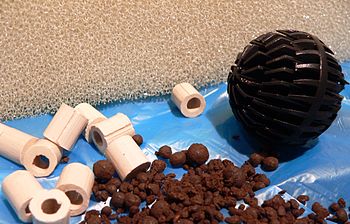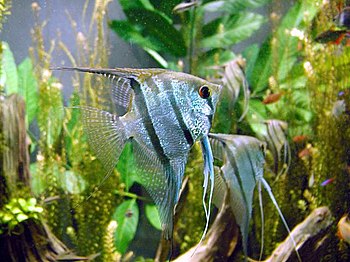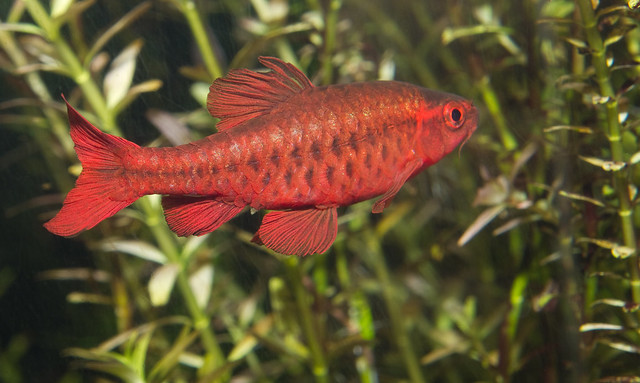  |
Sponges, plastic balls, ceramic tubes and gravel
are all suitable for aquarium filtration
(Photo credit: Wikipedia) |
Accessories Needed to Enrich Your Aquarium. There are many items on the market to make the maintenance of your aquarium easier! Some of these include:
* Timers: Timers aid you in supplying a consistent amount of daily light to your aquarium that is not possible when using a manual system of turning your lights on and off.
* Automatic Feeders: These are great if you travel; however, they should not be used for daily feeding as you need to spend a little time each day to check on the fish and make sure the aquarium is set up and running properly.
*Ozone Treatments: Ozone kills bacteria and speeds the breakdown of nitrates and it is a priceless aid for fish breeding. In soft water, the pH can be affected to the point that it can endanger the fish.
*Ultraviolet Radiators or Sterilizers: These are also reliable in killing bacteria and other water germs without reaching the established bottom bacteria that is necessary for a biological filter system. If your fish suddenly begin shooting and reeling through the water, they may be suffering from nitrite poisoning, a very bad side effect of UV radiators. If this occurs, the fish must immediately be placed in non-toxic aged aquarium water!
*Carbon Dioxide: Essential to plant growth in aquariums. It can be dissolved in the water by carbonation and plants will stagnate without carbon dioxide. Pouring carbonated water into your aquarium is one of the simplest ways of providing carbon dioxide to your plants. However, carbonated water contains salt, either added for flavor or it is naturally present. This is dangerous for your fish.
*Water Softeners: These may be necessary for most of your decorative tropical fish come from mineral poor waters or soft waters. Most fish can easily survive in hard water, but if you want to breed or raise tropical fish, soft water is a necessity.
There are many other useful accessories for your aquarium from automatic water changes to adhesive films that show a plant design to magnets for cleaning the front glass. Check with your pet store to see what is available in your area.
Aquarium Filters
Filters remove small particles and debris from the water. While these small particles are not dangerous to the fish, they do hinder plant growth by filtering the light they need to grow. In addition, they aid in gas exchange (oxygen and carbon dioxide) and prevent warm patches in the aquarium by circulating the water.
One type of filter for aquariums is a biological filter which includes material such as coarse gravel, basalt splinter, ceramic tubes, and lavalit. After a few weeks, the materials become covered with bacteria. However, the bacteria perform an important job in an aquarium in that it decomposes any deposited organic substances (from old fish food, and fish excrement).
What is being described here is bio-mineralization. The tank byproducts are oxygen, nitrates, sulfates, and phosphates which are absorbed by the plants as nutrients.
Certain things must be taken into consideration before selecting a biological filter:
* The ratio of plants to fish to bacteria will never be balanced.
* The best filter can't replace the need for an occasional partial water change.
* The bacteria need oxygen and this is usually acquired by the water that is pouring through the filter. If the filter is turned off for several hours the bacteria will suffocate and die.
* A biological filter should never be turned off for more than 1-2 hours at most.
* In the beginning, you must be careful of the number of fish you stock and the amount of food that is given at feeding time as bacteria are too few to be able to effectively convert the organic waste.
Even with a bacteriological filter, the filter mass needs to be cleaned occasionally. During this cleaning, only the debris is removed by rinsing with cool-to-lukewarm water. Excessive cleaning will destroy the valuable bacteria, leaving a small amount of the strata uncleaned in the filter will assure that the bacterial cultures will regenerate themselves.
Angelfish
 |
| Freshwater angelfish - (Photo credit: Wikipedia) |
Angelfish are large and very decorative cichlids which are found in the majority of community aquariums. The wide variety of shapes, colors, and sizes make them a beautiful and entertaining addition to our aquariums. The Angelfish is a very undemanding decorative fish that are majestically calm and long-finned.
Angelfish do not eat plants and are available in several varieties:
* Veil fins
* Albino
* Marbles
* Silver
A few rules must be observed when introducing Angelfish to your tank. Angelfish need well-planted tanks at least 1-meter side length but have no other special needs other than an occasional feeding of live food. However, if they are combined with smaller fish when they are fully grown they may eat their smaller companion fish.
Angelfish immensely enjoy chasing small Neon's. The danger is always present and recognizable until the angelfish becomes fully grown and decides his liking for neon food! Another equally deadly combination with Angelfish is Headstanders. At some point, Headstanders realize that the skin mucus of the angelfish is very tasty, and they begin to use the angelfish as take-out food! The Headstanders can damage the skin of the angelfish to the point that the angelfish can and will die.
Other than these two species, Angelfish can be easily mixed with other livebearers with an excellent outcome. A pair of angels that are ready to spawn need their water to be very soft and slightly acidic. It is usually best to keep them in a tank that is highly planted with no companion fish. Their eggs are laid on a large leaf, root, or a rock, and should be transferred to a different tank to hatch away from their parents because Angelfish are notoriously bad parents and do not properly care for their brood.
Many breeding books give detailed instructions on breeding angelfish and hundreds of other types of fish.










